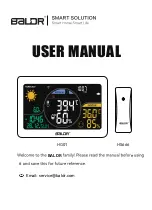
Aercus Instruments™
- WeatherMaster
77 |
P a g e
is 4 x the distance of the tallest obstruction. For example, if
your house is 8m tall and you mount the sensor on a 2m pole:
Here, the distance to mount away from house = 4 x (8 – 2) =
24m.
Many installations are not perfect and installing the weather
station on a roof can be difficult. Thus, you can calibrate for this
error with a wind speed multiplier.
In addition to the installation challenges, wind cup bearings
(moving parts) wear over time.
Without a calibrated source, wind speed can be difficult to
measure. We recommend using a calibrated wind meter and a
constant speed, high speed fan.
(7)
The rain collector is calibrated at the factory based on the
funnel diameter. The bucket tips every 0.3mm of rain (referred
to as resolution). The accumulated rainfall can be compared to
a sight glass rain gauge with an aperture of at least 10cm.
Make sure you periodically clean the rain gauge funnel.
Note:
The purpose of calibration is to fine tune or correct for any sensor
error associated with the devices margin of error. Errors can occur due to
electronic variation (example, the temperature sensor is a resistive thermal
device or RTD, the humidity sensor is a capacitance device), mechanical
variation, or degradation (wearing of moving parts, contamination of
sensors).
Calibration is only useful if you have a known calibrated source, you can
compare it against, and is optional. This section discusses practices,
procedures, and sources for sensor calibration to reduce manufacturing
and degradation errors. Do not compare your readings obtained from
sources such as the internet, radio, television or newspapers. The purpose
















































